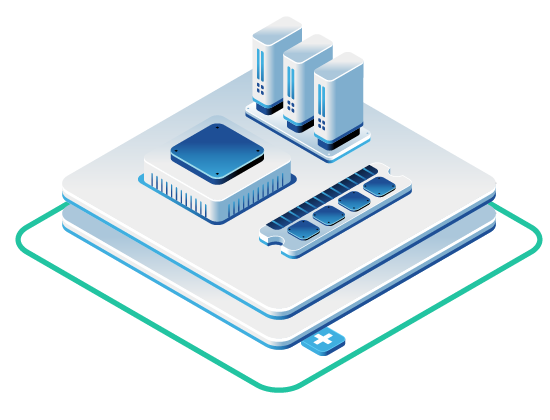In this article
- The Problem With Provider-Owned IP Addresses
- When BYOIP Becomes Non-Negotiable
- Not All BYOIP Is Created Equal
- OpenMetal’s Implementation for Enterprise Networking
- Making BYOIP Work for Your Architecture
- The Economics of Infrastructure Portability
- What This Means for Your Infrastructure Strategy
Your infrastructure has grown significantly over the past three years. Maybe you’re running analytics pipelines processing terabytes of data daily, operating API services that partners depend on, hosting customer-facing applications with strict SLA requirements, or managing workloads with compliance requirements across healthcare, financial, or government sectors. Your network architecture includes IP addresses that external systems depend on – firewall rules, DNS records, API endpoints, email reputation, security controls.
Then your cloud bill arrives showing six figures for the month, and leadership asks the inevitable question: “Can we get better pricing somewhere else?”
The answer should be straightforward. But it’s not. Because your hyperscaler owns your network identity, and moving means changing every IP address your infrastructure depends on. Partners need to update firewall rules. DNS propagation takes days. Email deliverability plummets as IP reputation resets to zero. The migration project that should take weeks stretches into months.
This is the hidden cost of vendor lock-in, and it’s completely unnecessary.
The Problem With Provider-Owned IP Addresses
When you deploy infrastructure on AWS, Azure, or Google Cloud, you’re not just renting compute and storage. You’re also accepting their networking model, which includes using IP addresses they own and control.
For small deployments or simple applications, this works fine. Spin up a few instances, get some elastic IPs, connect your DNS, and you’re operational. The hyperscalers make this deliberately easy because they want you in their ecosystem.
The problems emerge at scale, or when you need genuine infrastructure portability.
IP Reputation Takes Years to Build
If you operate any service that sends email, makes API calls to external systems, or connects to partners with IP-based access controls, your IP addresses carry reputation. Email providers track sender reputation by IP address. Move to new IPs, and you’re starting from scratch. What was 99% deliverability becomes 60% until you rebuild trust, which can take months.
Security systems maintain threat intelligence databases by IP. A clean IP address is valuable. An IP with unknown history creates risk. Large enterprises operating security infrastructure know this, which is why they maintain their own IP space and bring it wherever their workloads run.
DNS Changes Cascade Through Systems
Every DNS record pointing to your infrastructure needs updating when IP addresses change. For companies with hundreds of service endpoints, API integrations, and customer-facing applications, this becomes a complex migration project. DNS propagation takes 24-48 hours in the best case. During this window, some users reach old endpoints while others reach new ones. If you’re running any kind of session-based service or real-time application, this split-brain situation creates serious operational problems.
Firewall Rules Don’t Update Themselves
Enterprise partners, customers, and internal security policies maintain strict firewall configurations. Your organization’s specific IP ranges have been approved after security review and change control processes. When those IPs need to change, the coordination effort multiplies:
- External partners submit change requests through their IT governance processes
- Internal security teams schedule maintenance windows for firewall updates
- Updates cascade across multiple environments (development, staging, production)
- Coordination spans teams, departments, and possibly multiple business units
- Changes require documentation and audit trails for compliance
For larger organizations with complex infrastructure, this process takes weeks. When you’re coordinating with dozens or hundreds of external partners plus internal stakeholders, you have a migration project that significantly impacts operations and business relationships.
The Competitive Implications Are Real
This isn’t just operational inconvenience. It’s strategic limitation. When infrastructure portability is difficult, you can’t:
- Negotiate aggressively with cloud providers (they know you’re locked in)
- Take advantage of better pricing or features from alternative providers
- Implement genuine multi-cloud architecture for resilience or performance
- Respond quickly to vendor issues or service degradation
- Meet customer requirements for specific data center locations or providers
Your infrastructure decisions become constrained by what happens to be convenient for your current vendor rather than what’s best for your business.
When BYOIP Becomes Non-Negotiable
Bring Your Own IP (BYOIP) support shifts control over network identity from your provider to you. Instead of accepting IP addresses assigned by AWS or Azure, you use IP space you own or lease long-term, and your infrastructure provider announces those prefixes from their network.
This capability moves from “nice to have” to “business critical” in several common enterprise scenarios.
Multi-Region Architecture for Global Services
If you operate services with users distributed globally, you want infrastructure in multiple regions to minimize latency. The challenge is maintaining consistent routing and identity across those regions.
With BYOIP and anycast routing, you can announce the same IP prefix from multiple data centers. Users automatically connect to the geographically nearest location through BGP routing, with automatic failover if a region becomes unavailable. Your DNS remains simple because you’re advertising identical addresses from multiple locations rather than managing regional endpoint mapping.
OpenMetal’s support for BYOIP combined with data center locations in California, Virginia, Amsterdam, and Singapore makes this architecture practical. You maintain a single IP space for your global footprint while traffic routes optimally based on user location. Learn more about optimizing latency and egress costs for globally distributed workloads.
Without BYOIP capability, multi-region deployment means different IP ranges per region, complex DNS management, and no transparent failover. You’re managing network complexity rather than delivering better user experience.
Hybrid Cloud and Migration Flexibility
Genuine hybrid cloud architecture requires consistent networking between on-premises infrastructure and cloud resources. When IP addressing is unified across environments, routing is straightforward. Applications don’t need to know whether they’re connecting to on-premises databases or cloud services because network policies work identically.
BYOIP enables workload migration without network disruption. Move your application from your data center to hosted infrastructure, or from one cloud provider to another, and the IP addresses move with it. DNS doesn’t change. Firewall rules remain valid. Integrations continue working.
This flexibility has real business value. If a cloud provider’s pricing becomes uncompetitive, or their service quality degrades, or they announce a feature deprecation that impacts your architecture, you have options. Without BYOIP, you’re in the uncomfortable position of negotiating from weakness because the provider knows migration is painful.
API Services and Webhook Infrastructure
Services that expose APIs to external systems often deal with IP-based authentication or access control. Your API documentation specifies IP ranges. Partners configure firewalls to accept webhook callbacks from your known addresses. Changing those addresses means coordinating with potentially thousands of integration partners.
BYOIP ensures your API endpoints maintain consistent addresses regardless of infrastructure changes. Scale your backend across providers, migrate between data centers, or implement disaster recovery failover without impacting external integrations. Your network identity remains stable even as infrastructure evolves.
Email and Reputation-Dependent Services
Operating email infrastructure at scale requires maintaining IP reputation across multiple addresses. Email providers and spam filters track sender reputation by IP. If you need to change mail server IPs frequently, deliverability suffers dramatically.
With BYOIP, your email infrastructure maintains consistent IP addresses even if you change underlying infrastructure providers. The reputation you’ve built over months or years travels with your IP space rather than being abandoned when you need infrastructure flexibility.
This applies beyond email to any system where IP reputation matters, including API rate limiting, fraud prevention systems, or DDoS mitigation services that use IP-based reputation signals.
Compliance and Audit Requirements
Regulated industries often require detailed documentation of infrastructure including network addressing. Audit processes assume stable, predictable infrastructure. When you use provider-assigned addresses that can change with infrastructure modifications, audit documentation becomes more complex.
BYOIP provides consistency that simplifies compliance documentation. Your IP space is documented once. Auditors can verify network controls knowing the addresses remain stable. This is particularly important for organizations in healthcare, financial services, or government sectors where infrastructure changes require additional documentation and approval.
Not All BYOIP Is Created Equal
Just because a cloud provider claims to support BYOIP doesn’t mean their implementation meets enterprise requirements. The differences matter significantly when you’re architecting production infrastructure.
Minimum Block Size Requirements
Many hyperscalers support BYOIP, but with restrictions that limit its usefulness. AWS requires a minimum of /24 (256 addresses) for IPv4 BYOIP, which sounds reasonable until you realize that obtaining and maintaining a /24 allocation from a regional internet registry costs thousands of dollars annually and requires justification of address utilization.
For organizations that already own IP space, this is manageable. For companies evaluating infrastructure portability for the first time, the barrier to entry is substantial.
The minimum block size also determines flexibility. If you’re bringing a /24 but need to split that addressing across multiple regions, applications, or security zones, the limitation becomes constraining.
OpenMetal supports BYOIP for /24 and larger blocks, matching industry standards for organizations that own their IP space. For companies starting fresh, OpenMetal can provide dedicated IP blocks including /28 allocations (16 addresses) as standard with private cloud deployments. While these provider-allocated addresses don’t offer the same portability as true BYOIP, they’re dedicated to your deployment and can be used consistently within OpenMetal’s infrastructure across data centers.
BGP and Routing Capabilities
True BYOIP requires BGP support at your provider’s edge routers to announce your prefixes to the global internet routing table. This is more complex than simple NAT or IP assignment and requires networking infrastructure that many providers don’t offer or make difficult to access.
When evaluating BYOIP support, understand:
- Can your provider announce your prefix globally, or only in specific regions?
- Do they support route filtering to control where your prefix is announced?
- Can you implement anycast routing with the same prefix announced from multiple locations?
- What ASN (Autonomous System Number) will be used for BGP announcements?
OpenMetal’s infrastructure provides BGP support through edge routers with direct internet connectivity. Your IP blocks can be announced globally with DDoS protection included up to 10 Gbps per IP address. This matters because DDoS mitigation at the edge, before malicious traffic reaches your infrastructure, prevents resource exhaustion.
Integration With Networking Services
BYOIP becomes significantly more useful when it integrates cleanly with other networking features. If you can bring your own IPs but can’t use them with load balancers, implement firewall rules consistently, or route traffic through private VLANs, the capability has limited value.
OpenMetal’s implementation allows BYOIP addresses to be used throughout the networking stack:
- Attach addresses directly to instances for maximum throughput
- Route traffic through OpenStack load balancers for high availability
- Implement firewall rules at the hardware level for instance protection
- Use addresses within private cloud VPCs for internal services
- Integrate with VPN connections for hybrid architectures
The networking flexibility extends to how traffic is managed internally. OpenMetal’s infrastructure provides dedicated VLANs per customer for both bare metal and cloud deployments, with dual 10 Gbps private links per server (20 Gbps total). This private networking is unmetered and isolated, so internal traffic between your servers doesn’t compete with or consume public bandwidth allocation.
Public Network Performance and Costs
BYOIP capability becomes more valuable when combined with predictable bandwidth costs and high-performance connectivity. There’s limited benefit to maintaining your IP identity if bandwidth costs are prohibitive or network performance is inconsistent.
OpenMetal provides dual 10 Gbps uplinks per server (20 Gbps total aggregate) of private bandwidth. Each server type includes baseline public bandwidth:
- XL servers: 4 Gbps included per server
- Large servers: 2 Gbps included per server
- Medium servers: 1 Gbps included per server
For clusters, these allowances aggregate. Three XL servers provide 12 Gbps total included egress capacity.
Beyond included amounts, egress is billed using 95th percentile measurement at $375 per Gbps (approximately 180 TB monthly at sustained rates). This billing method averages peak traffic over the month, ignoring the top 5% of measurements. You can exceed your committed rate for brief periods without triggering overage fees, which makes sense for real-world traffic patterns that spike during business hours or seasonal events.
Compare this to hyperscaler egress pricing that charges per-gigabyte with rates from $0.05 to $0.12 per GB after minimal free tiers. At scale, bandwidth costs alone can justify infrastructure alternatives, and when combined with BYOIP support for portability, the economics improve substantially. Read more about the hidden costs of hyperscaler networking and how OpenMetal’s model provides cost predictability.
OpenMetal’s Implementation for Enterprise Networking
OpenMetal’s approach to networking prioritizes transparency and control rather than abstraction. This matters for organizations that need to understand exactly how traffic flows, where costs occur, and what performance to expect. Learn more about why network architecture still matters in modern cloud infrastructure.
Dedicated Infrastructure Without Shared Bottlenecks
Every OpenMetal server connects through dedicated links with no oversubscription. When specifications indicate 20 Gbps total connectivity (dual 10 Gbps NICs), that’s physical capacity dedicated to your server, not theoretical maximum in a shared environment.
Private networking operates on customer-specific VLANs. Your internal traffic between servers is completely isolated from other customers and unlimited. This architecture matters for workloads that generate significant east-west traffic, like distributed databases, storage replication, or cluster coordination.
Public connectivity provides similar predictability. Each data center location has a minimum of 200 Gbps edge connectivity. When you deploy infrastructure, you know your servers have consistent access to internet bandwidth without competing with other tenants for oversubscribed uplinks.
Network Architecture You Can See and Control
OpenMetal provides access to network infrastructure that hyperscalers abstract away. You get IPMI (Intelligent Platform Management Interface) access to servers, allowing hardware-level management even when operating systems are unreachable. Configure BIOS settings. Manage network interfaces directly. Troubleshoot hardware issues with full visibility.
Within OpenStack, you have complete control over network topology:
- Create Virtual Private Clouds (VPCs) with custom IP ranges and subnets
- Implement VXLAN overlay networks for logical isolation
- Configure virtual routers with custom routing policies
- Set up firewall rules and security groups per-project
- Deploy VPN-as-a-Service for external connectivity
- Attach floating IPs (including BYOIP addresses) to instances as needed
This level of control is standard in OpenMetal deployments rather than being restricted to enterprise tiers or requiring special support requests. Network configuration is accessible through the OpenStack API, Horizon dashboard, or OpenMetal Central for orchestration across your entire infrastructure. Learn more about OpenMetal’s network architecture including VLANs, VXLANs, and private networking.
Rapid Deployment Without Sacrificing Capability
One persistent myth about private cloud infrastructure is that capability requires complexity and long deployment cycles. OpenMetal’s implementation demonstrates this is false.
Production-ready private clouds deploy in approximately 45 seconds through proprietary automation. This includes a three-server Cloud Core running OpenStack and Ceph in hyperconverged configuration, providing both control plane management and compute/storage resources.
Adding servers to existing clusters takes approximately 20 minutes. Scale compute capacity, add storage nodes, or expand to additional data center locations without lengthy provisioning cycles or complex integration projects.
The speed comes from opinionated, preconfigured deployments based on proven architectures. Rather than requiring decisions about hundreds of configuration options, OpenMetal provides tested configurations optimized for most enterprise workloads. For organizations needing deeper customization, Kolla-Ansible-based deployments provide full control over OpenStack service configuration.
This approach balances operational simplicity with technical capability. You get enterprise-grade private cloud infrastructure without needing to become an OpenStack expert, but if you want deep customization, the platform supports it.
Geographic Distribution With Unified Management
 OpenMetal operates data centers in four locations spanning three continents:
OpenMetal operates data centers in four locations spanning three continents:
- Los Angeles, California (Americas)
- Ashburn, Virginia (Americas)
- Amsterdam, Netherlands (Europe)
- Singapore (Asia-Pacific)
Deploy infrastructure across locations while managing everything through a unified control plane. OpenMetal Central provides oversight across all deployments including team management, budget controls, and hardware allocation per cloud.
For organizations implementing multi-region architecture, this geographic distribution combined with BYOIP support enables sophisticated deployment patterns. Announce your IP space from multiple locations for anycast routing. Implement cross-region replication for disaster recovery. Serve users from nearby data centers to minimize latency.
The network performance between these locations also matters. While east-west traffic within a data center location is unmetered and operates at full link speed, traffic between your deployments in different data centers uses the same egress billing as public internet traffic. Architect appropriately by minimizing cross-region synchronous operations and optimizing for asynchronous replication patterns where possible.
Integration With Enterprise Operations
OpenMetal’s infrastructure integrates with standard enterprise tooling rather than requiring proprietary management systems. The platform is built on open source technologies (OpenStack, Ceph, Kolla-Ansible, Docker) that have extensive community documentation and support.
Infrastructure-as-code tools work as expected:
- Terraform providers for OpenStack resources
- Ansible playbooks for configuration management
- Kubernetes deployment through OpenStack Magnum
- Direct API access for custom automation
This matters because it reduces the operational overhead of adopting new infrastructure. Your team’s existing skills and tools remain relevant. You’re not learning a provider-specific management interface that has no transferable value.
For organizations needing additional support during migration or operations, OpenMetal offers engineer-assisted onboarding and dedicated Slack channels for direct access to infrastructure experts. Assisted management services are available for companies that want private cloud benefits without building in-house OpenStack expertise.
Making BYOIP Work for Your Architecture
Understanding BYOIP capability is different from implementing it effectively. Several architectural patterns benefit specifically from IP portability.
Active-Active Multi-Region Deployment
Deploy identical infrastructure in multiple data center locations and use anycast BGP to announce the same IP prefix from each location. Users connect to whichever location is closest based on internet routing. If one region becomes unavailable, traffic automatically shifts to remaining locations without DNS changes or manual failover.
This architecture requires:
- Identical application stacks in each region
- Stateless application design or replicated session storage
- Database replication (asynchronous for performance, or synchronous where consistency is critical)
- Health checks and automatic deprovisioning of failed locations
OpenMetal’s infrastructure supports this pattern with BYOIP across data centers, but be mindful of cross-region data transfer costs. Design for eventual consistency where possible rather than synchronous cross-region database writes. Learn more about building multi-site high availability infrastructure.
Hybrid Cloud With Consistent Addressing
Extend your on-premises infrastructure with cloud resources while maintaining unified IP addressing and network policies. Allocate IP space from your organization’s owned blocks to both on-premises systems and OpenMetal infrastructure.
Implement private connectivity between locations using VPN (OpenStack VPN-as-a-Service provides point-to-point VPN functionality) or dedicated cross-connect where available. Your applications see a unified network whether resources are on-premises or in hosted infrastructure.
This architecture enables gradual cloud migration without forcing large-scale network redesign. Move workloads incrementally while maintaining existing network architecture, firewall policies, and security controls.
Disaster Recovery With Instant Failover
Maintain production infrastructure in one data center and disaster recovery capacity in another. Use BYOIP to ensure your production IP addresses can be announced from the DR location during failover events.
Configure automated health checking. When primary location becomes unavailable, initiate BGP route changes to announce your IP space from the DR location. DNS doesn’t change because you’re using the same addresses. Traffic shifts to the DR location within BGP convergence time (typically under 5 minutes globally).
This is significantly faster than DNS-based failover, which requires propagation time and cache expiration across the internet. For critical services requiring rapid recovery, IP-level failover provides better RTO (Recovery Time Objective).
Progressive Migration Strategy
When moving infrastructure between providers, BYOIP enables progressive migration rather than forced cutover events. Deploy new infrastructure on OpenMetal using your organization’s IP space. Gradually shift traffic by adjusting load balancer configurations or updating routing policies. Run parallel infrastructure during the transition period to verify functionality before fully committing.
This reduces migration risk substantially. Instead of a weekend cutover project where everything must work immediately, you can validate each component, test under production traffic, and roll back if issues emerge.
The Economics of Infrastructure Portability
BYOIP capability has direct economic value beyond the obvious benefit of avoiding vendor lock-in.
Negotiating Position With Providers
When infrastructure is genuinely portable, you can negotiate aggressively with providers. They know you have alternatives and can actually execute on them without major disruption. This changes pricing conversations substantially.
Cloud providers compete on price when they know you can leave. Without portability, they optimize for margin because switching costs prevent customer defection.
Cost Optimization Without Architectural Rewrites
Different workloads have different economics at different scales. As your infrastructure grows, the cost-optimal provider can change. With BYOIP, you can move workloads to providers with better pricing for your specific usage patterns without rewriting applications or changing integrations.
For example, object storage economics favor different providers depending on whether your workload is read-heavy, write-heavy, or has significant delete operations. The optimal choice changes over time as your data patterns evolve. BYOIP for storage endpoints means you can optimize provider selection without impacting applications consuming those storage services.
Disaster Recovery Cost Reduction
Traditional DR architecture maintains expensive hot standby infrastructure that’s mostly idle. With BYOIP and rapid deployment capability, you can implement more cost-effective DR strategies.
Maintain configuration-as-code for your infrastructure. In disaster scenarios, deploy fresh infrastructure on OpenMetal (45 second cloud deployment time), announce your IP space from the new location, and restore data from backups or replicated storage. You’re paying for backup storage and minimal standby resources rather than full parallel infrastructure.
This isn’t appropriate for all workloads, but for many applications with multi-hour RTO requirements, it dramatically reduces DR infrastructure costs.
What This Means for Your Infrastructure Strategy
The difference between portable infrastructure and vendor-locked infrastructure compounds over time. Early in a project, when infrastructure requirements are small and uncertain, using provider-assigned IP addresses seems fine. The convenience outweighs concerns about future portability.
But infrastructure decisions made for convenience early in a project become constraints that limit options later. By the time IP portability matters to your business, changing the architecture is significantly more difficult.
Organizations building for the long term should evaluate BYOIP support as a required capability rather than a nice-to-have feature. The operational flexibility, competitive positioning, and cost optimization opportunities justify the modest additional complexity of owning or managing your IP space.
OpenMetal’s BYOIP support (for /24 and larger blocks) combined with provided IP allocations (including /28 blocks with standard private cloud deployments) gives you options. Start with provided addressing if you’re exploring private cloud infrastructure or don’t currently own IP space. As your requirements evolve and your infrastructure scales, transition to BYOIP when it makes sense for your business.
The key insight is that infrastructure portability isn’t just about where your servers run. It’s about maintaining control over your network identity so you can make infrastructure decisions based on technical and economic merit rather than being constrained by migration complexity.
Your IP addresses are part of your business identity. Maintaining control over them means maintaining control over your infrastructure options. The hyperscalers built their businesses by making infrastructure convenient, but that convenience comes at the cost of portability and flexibility.
For enterprise workloads operating at scale, that’s a trade-off that no longer makes sense.
Schedule a Consultation
Get a deeper assessment and discuss your unique requirements.
Read More on the OpenMetal Blog


































